
Performer: Lina Hartmann & Laura Boser



Tafelhalle, Nuremberg, 2025
Tafelhalle, Nuremberg, 2025
Tafelhalle, Nuremberg, 2025
CLICK 2 OPEN =>
Anti Apocalyptic Autolysis is a work in progress research process which started as a stage/sound & costume design for the dance piece 'Curious Space' by Alexandra Rauh in 2025.
It's sculptural and installative vegetation is made of self developed copper wire coil microphones that pick up electromagnetic fields. They provide a playful environment for interaction via magnets or electronics. Simone Körner developed costumes and objects with integrated magnets. The costumes and objects together with the installation allow to trigger sound via movement. The dance piece was a first product of this research project, which is still in development.
How did metaphors of electricity (energy=work=life) become material as infrastructures of our disastrous modern lives’ (Cara New Dagget)? How did actual practices (electroshock therapy, geopsychiatry, rave, bass) with waves, frequencies, vibration and (electro)magnetism search for a re-organization of our bodies and their (im)possibility to be in the world, (dis)embodied (Frantz Fanon, Francoise Tosquelle, Charlotte Wolff)? If madness is the only possible antiapocalyptic relation to the impossible apocalyptic world we live in, how can it be re-organized to a social possibility?

AdbK, Nuremberg, 2024
Live performance of my song LICENCE from my upcoming album. My voice and the beat is played through a sculptural sound system. A drum with a mirror moved by the sound of my voice and the beat. It is hard to capture the movement on camera because of the framerate. The video is a documentation of the performance, which should be recieved live.


Kongresshalle, Segment I, Nuremberg, 2023
Kongresshalle, Segment I, Nuremberg, 2023

Wiegenlied, 2023, site specific sound installation, two stadium speaker stacks
Ein Wiegenlied beruhigt. Es summt uns in den Schlaf, flüstert „alles wird gut“.
Aus den zwei weit voneinander entfernten, sich gegenüberliegenden Stadionlautsprechern wiegt Alexandru Șalariu uns jedoch nicht in einen Schlaf, noch werden wir beruhigt. Wir befinden uns mitten in den wogenden Wellen der ambivalenten Verfassung der Gegenwart. Zwischen den drängenden Motorengeräuschen des Norisrennens und den Sounds des tauenden Eises auf dem Dutzendteich, entfaltet sich eine Melodie. Șalariu sucht das historisch aufgeladene ehemalige Reichsparteitagsgelände aus sehr gegenwärtigen Diskussionen heim und wirft uns dabei auf uns selbst zurück.
Wollen wir doch die Strukturen unseres Vergnügens auf dem ehemaligen Reichsparteitagsgelände nicht hinterfragen. Momentan wird dieses Nazierbe nicht nur für das Dokumentationszentrum, sondern vor allem für Volksfeste, Rockfestivals, Motorsport und durchaus für neonazistische Zusammenkünfte genutzt. Schon die italo-faschistischen Künstler des Futurismus waren vom Motor und seiner Geschwindigkeit fasziniert. Auch die Nationalsozialisten waren geschwindigkeitsversessen und gebrauchten den Motorsport propagandistisch als Symbol für Fortschritt und Überlegenheit. Inwiefern sind der Verbrennermotor und sein Versprechen von unendlicher Freiheit, Losgelöstheit, Geschwindigkeit und Privatheit heute symbolisch dafür geworden, dass Faschismus eigentlich nie aufgehört hat? „Everybody wants to be a fascist“ schrieben schon Deleuze und Guattari und Cara New Daggett zieht in ihrem Buch „Petromaskulinität“ einen Zusammenhang zwischen fossiler Energie und autoritärem Begehren. Was hat die Klimakatastrophe und der erstarkende Rechtsruck, der sich nicht erst seit dem NSU abzeichnet, mit unserer Begehrensstruktur zu tun und wie zeigt sich dies in der Verwendung des Reichsparteitagsgeländes? Die Motoren werden in der Soundkomposition zu einem dekonstruierten, langsamen und gebrochenen Rave-Beat. Dagegen stehen die zarten und wundersamen Sounds des zugefrorenen Teichs. Durch das Schmelzen entstehen kleine Risse, ein kontinuierlicher Verlust von Spannung, der einen unerwarteten Klang als Körperschall im Eis erzeugt und mit einer Klima-Melancholie belegt ist: Wird der See in ein paar Jahrzehnten überhaupt noch gefrieren? Energie wird in beiden Sounds nahezu verschwenderisch entfesselt. Welcher Erzählung wollen wir lauschen? Aus den beiden antagonistischen Kräften von Motor und Eisschmelze erschöpft sich eine Melodie. Sie lässt uns in unserer eigenen Traurigkeit wiegen, in dem Verlust dem wir begegnen, wollen wir anerkennen, dass nichts so bleiben kann, wie es mal war. Sie umhüllt uns, wiegt uns in der Erzählung von Möglichkeit, in der Selbstverlust zwar Schmerz bedeutet, aber auch Schönheit.
Text von Simone Körner
A Wiegenlied soothes. It hums us to sleep, whispering "everything will be fine".
(Wiegenlied = "cradle song"/lullaby - wiegen = to rock/to sway/to cradle)
However, Alexandru Șalariu does not lull us to sleep from the two stadium loudspeakers, which are far apart and opposite each other, nor are we calmed. We find ourselves in the middle of the surging waves of the ambivalent state of the present. A melody unfolds between the urgent engine noises of the Norisrennen (car race at the former Nazi Party Rally Ground) and the sounds of the thawing ice on the Dutzendteich (a pond next to the Kongresshalle). Șalariu haunts the historically charged former Nazi Party Rally Grounds from the perspective of very contemporary discussions, throwing us back on ourselves.
Apparantly we do not want to question the structures of our pleasure on the Nazi Party Rally Grounds. At the moment, this Nazi heritage is not only used for the Documentation Centre, but above all for folk festivals, rock festivals, motor sports and indeed for neo-Nazi gatherings. Even the Italo-fascist Futurist artists were fascinated by the engine and its speed. The Nazis were also obsessed with speed and used motorsport for propaganda purposes as a symbol of progress and superiority. To what extent has the combustion engine and its promise of infinite freedom, detachment, speed and privacy come to symbolise the fact that fascism has never really ended? "Everybody wants to be a fascist" wrote Deleuze and Guattari and Cara New Daggett draws a connection between fossil energy and authoritarian desire in her book "Petromasculinity". What do the climate catastrophe and the growing shift to the right, which has been emerging not only since the NSU, have to do with our desire structure and how is this reflected in the use of the Nazi Party Rally Grounds? In the sound composition, the engines become a deconstructed, slow and broken rave beat. In contrast, there are the delicate and wondrous sounds of the frozen pond. The melting creates small cracks, a continuous loss of tension that produces an unexpected sound as structure-borne noise in the ice and is tinged with a climate melancholy: will the lake even freeze a few decades in the future? Energy is unleashed almost wastefully in both sounds. Which narrative do we want to listen to? A melody emerges from the two antagonistic forces of motor and melting ice. It lets us sway in our own sadness, in the loss we encounter, when we want to recognise that nothing can remain as it once was. It envelops us, cradles us in the narrative of possibility, in which self-loss means pain, but also beauty.
Text by Simone Körner



Between echo and reverb, we appropriate the air of the auditorium: Field recordings of our piss sounds trickle through the robots, broken down into the smallest fragments of „grains.“ According to Louis-Chude Sokei, the robot is the machine slave. It is supposed to take the work from us that we as masters do not want to do. We have visibly placed the infrastructure of their and our dependence over them in the auditorium. Energy is not a metaphor here, but a material condition. The robot here is not future, but remains of a racialized relation of labor in capitalism. Jeans, a fabric once used for work clothes, spills draped from the floor. It clothes itself with asphalt, becomes pools, and as it flows out over the ground, transforms into pants. They were sewn to the cut of a classic Mustang. Once worn by bodies, with spread crotch they whisper:“let me paint (you) in it, in places I don‘t want to see“. With oil paint we painted the crotches of the pants in several site vistis in public space. On car seats covered with blankets lie Vibras to put on the body with various furrows and hollows in which you can put your extremities. Between sex toy and massager, its playfulness frees us from fixation on the genital area. We want to extend Pleasure as soothing to the whole body, taking it into poses of care and tenderness. You are welcome to move into the swaying seat and apply the vibra to your own body. As protectors, the Pissshields allow us to take in places where we want to experience beauty, even though they have grown so ugly. Behind them is protection from exposure, as Lucky Charms they attach themselves to our bodies. In the auditorium they are guards, suffleuses of another possibility. I mean have you ever felt the rain, while you were lying on a warm street? Monochrome light settles in the room and around us when it gets dark. We want to found the Pisssister* association! Streamlining against the dam man aka. facism and patriarchy in us and around us. We want to establish urinism! The idea of this exhibition was formed after visiting the exhibition „To be seen. Queer Lives“ at the Documentation Center in Munich. What are the remains of a lifeform? Where is artistic practice a material necessity?

LfA Kunstkalender 2023 (Foto: Robert Brembeck)





AdbK, Nuremberg, 2023 (Foto: Laila Auburger)
AdbK, Nuremberg, 2023 (Foto: Laila Auburger)
AdbK, Nuremberg, 2023 (Foto: Laila Auburger)
AdbK, Nuremberg, 2023 (Foto: Laila Auburger)
AdbK, Nuremberg, 2023 (Foto: Laila Auburger)
The vibras, which vibrate in bassy sounds, encourage you to put them on your body with various furrows and hollows in which you can place your extremities and which comfort your hand. The object is meant to allow a playful exploration of tactile experience. It sits somewhere between futuristic machine part and sex toy, liberating the playfulness of the vibrator from its fixation on the genital area and extending it to the whole body. Vibration has been a constant companion of humans since industrialisation and the technification of our infrastructure, feeding our desire for the combustion engine that encapsulates us, envelops us in sound and lulls us down. The Vibras, on the other hand, artefacts of a shrunken automobile body, are carried by us like cocoons speaking to us about a time after the combustion engine. They naturally bring the body into poses of care and tenderness. The car seat on which the Vibra rests, draped in soft blankets like a baby in its cradle, is disguised. From below, vibration-damping foam, which is installed in cars, spills out of the seat. Sound, as vibration, is fundamentally tactile. In this respect, it is a logical consequence to extend hearing to the entire skin and to address the skin and the body in its entire physicality with vibratory sound art. This changes the accessibility for recipients and people with visual or hearing difficulties can also experience this tactile sound sculpture, perhaps even in a particularly good way. The ten-minute composition is played through built-in battery-powered electronics. The bass waves travelling through the body create a dissociative feeling. The hard 3d-printed object does not deliver the promised wellness and yet one does not want to let it go.

s



AdBK, Nuremberg, 2023 (Fotos: Lukas Jantschek)
AdBK, Nuremberg, 2023 (Fotos: Lukas Jantschek)
AdBK, Nuremberg, 2023 (Fotos: Lukas Jantschek)

s
Small objects form a still life arrangement on machined aluminum plates. Found industrial objects from the near past are contrasted with made objects produced with new-school industrial manufacturing processes like 3d-printing or laser engraving. Opposites that come together and give rise to different forms. Organic structures emerge from technical elements and evoke the desire to touch them. A personal collection, with the question of whether and how the use of an object can be questioned and rethought.
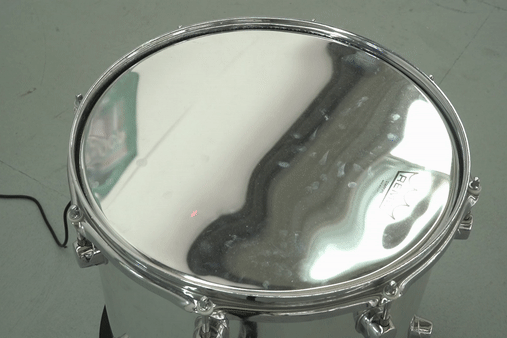
s


AdBK, Nuremberg, 2023 (Foto: Lukas Jantschek)
AdBK, Nuremberg, 2023 (Foto: Lukas Jantschek)
Alexandru Salariu
A mirrored drum with a built-in bass speaker, a laser pointer and certificate of naturalization form a (pseudo-)scientific set-up for the visual analysis of my voice. A recording of my voice moves the mirror and therefore the laser, which draws shapes on my official document of German citizenship. It is a contemporary variant of the phonautograph by Alexander Graham Bell, who tried to use his audio visualizing invention in 1872 to correct anomalies of pronunciation among the Deaf, without success. As a migrant, I made my anomalies invisible in an effort to become a proper German. My Romanian rolled 'R' remained. Vocal markings are interwoven with identity and class. A desire to suppress one's own roots is structurally present amongst migrants. All this is condensed into a tiny phonetic fragment.
2023, Heizhaus, Dry Run 2 (film shot by Kene Nwatu, cut by Alexandru Șalariu)
SAW WAVE - with Rudyard Schmidt, 2023, installative sound performance, two big circular saws, transducers, two microphones, two performers
Feedback loops make two huge circular saw blades vibrate in their resonances. An unreal drone of singing saws. A noise meditation to the sounds of industrial fossils.
(Foto: Eunice Maurice)






Albrecht Dürer Kunstverein, Nuremberg, 2022 (Foto: Lukas Pürmayr)
Albrecht Dürer Kunstverein, Nuremberg, 2022 (Foto: Lukas Pürmayr)
Kunsthalle Baden-Baden, 2021 (Foto: Eunice Maurice)
H!A, Auf AEG, Nuremberg, 2021
H!A, Auf AEG, Nuremberg, 2021
Tam Tam, Marienplatz, München-Pasing, 2020 (Foto: Florian Freund)
The Spatial Axis Activation Cube is an imploded multi-channel sound system with which sound can be sent in all directions and moved around the room. It is used for site specific installations and performances. Contrary to classical multi-channel speaker systems, the aim of the cube is not to create an immersive illusion of a fictitious acoustic space, but to project the sound directly onto the actual architectural space. The sound should not hit the listener’s ear as directly and unaltered as possible, but reach the listener after being reflected by the walls. The result is a three-dimensional cloud of sound, moving, swelling and surrounding the listener who cannot make out it’s source easily. With precise control the cube acoustically divides the room into a Cartesian coordinate system with each side aligning with one of the three axis: x, y, z. It cuts through space and constantly draws the attention of recipients to the acoustics of the architecture.




Edel Extra, Nuremberg, 2022
In this performance sound is moved spatialy in all directions via a selfbuilt, sculptural and installative sound system called the "spatial axis activation cube" (SAAC). With this cube Alexandru Salariu moves the sound around and splashes it against the walls of the architecture where it reflects and renders the specific acoustics of the space listenable. It is a play between the SAAC, the room and the body. Taking the resonant frequencies of the space to transform the architecture to a giant instrument adds another layer. Many sounds are derived directly from the architecture and let the bodies of the listeners plunge into a field of vibrations emitted by the whole surrounding.





H!A, Auf AEG, Nuremberg, 2021
H!A, Auf AEG, Nuremberg, 2021
H!A, Auf AEG, Nuremberg, 2021
H!A, Auf AEG, Nuremberg, 2021
After the demise of humanity, leftover technology and electrical inf rastructure comes to life and turns into vegetation. 3D-printed cacti and light reflecting aluminum-dibond prints whose aesthetics are reminiscent of mathematical fractal geometry or 3D renderings grow out of rising telephone cables and broken foot or hand rails in the dark. The installation provokes questions about the separation of nature and culture or life and technology but also civilization, institution and infrastructure. Cable strands connect to the pipes from all sides. The installation grows naturally from the construction site of Hall 14. The image prints are digitally processed natural motifs taken with a smartphone camera . The size, color, textures and structures were determined by the sample (the original photograph) from which the images were synthesized. This is a working method analogous to the creation of sample-based glitch music. By illuminating the images with a small lamp, details are playfully revealed as they reflect light like traffic signs.

s
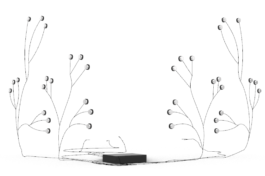
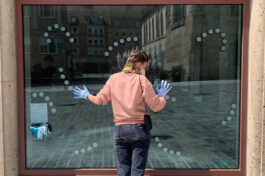
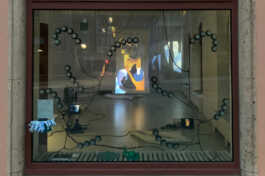
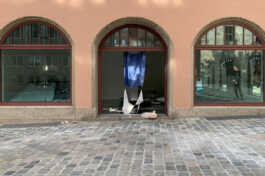
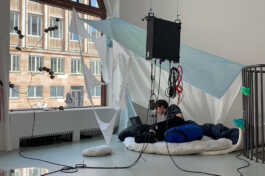


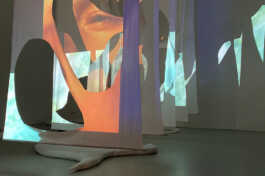
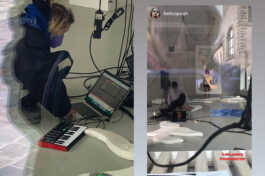
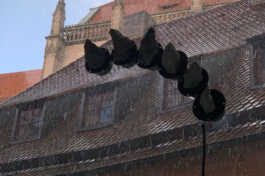
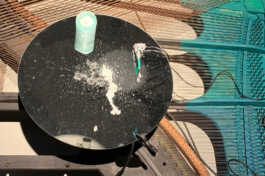
Akademie Galerie, Nuremberg, 2021
Akademie Galerie, Nuremberg, 2021
Akademie Galerie, Nuremberg, 2021
Akademie Galerie, Nuremberg, 2021
Akademie Galerie, Nuremberg, 2021
Akademie Galerie, Nuremberg, 2021 (Foto: Kira Krüger)
Akademie Galerie, Nuremberg, 2021
Akademie Galerie, Nuremberg, 2021
Akademie Galerie, Nuremberg, 2021
Akademie Galerie, Nuremberg, 2021
Akademie Galerie, Nuremberg, 2021
a wetness with limbs - with Simone Körner, 2021, expansive performance installation, ornamentic sound transducers attached to windows, amplifiers, beamer, cutout bed sheets, ornamentic pillows and mattrasses, sleeping bags, stripped and painted piano, round mirrors, 3d prints, dyed gloves, ceramics, metall balls, tattooing machine, and more...
peel (from) inside
edge out shell
lack a border
tear (out) holes
thirst outside
cut whole
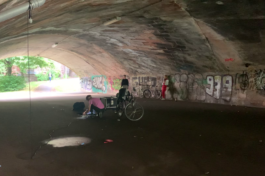

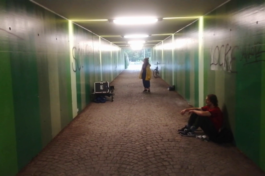
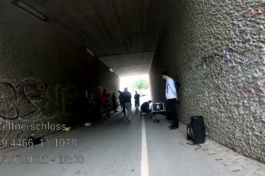
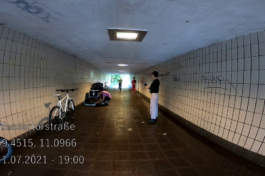
public space in Nuremberg
public space in Nuremberg
public space in Nuremberg
public space in Nuremberg
public space in Nuremberg
Sound as resonance frequency fills tubes that are made for humans. Tunnels and underbridges of the inner city of Nuremberg begin to pulsate. How it feels to be in a swelling body? The soundperformance let’s the air columns of our infrastructure s(w)ing like in a giant flute. While the sound is building up enveloping every body present a strange feeling of dissociation arises. The resonant frequencies create large standing waves which make sound physically perceptible as vibration in wave form while dissolving the contours of self perception.



Quarry at Untersberg, Austria
Quarry at Untersberg, Austria
I don't want to be a-part from you - with Simone Körner, 2020, site specific sound performance, resonance ritual, 25 minutes

Artissima, Torino, Italy, 2018

Art Berlin, Performance Agency, 2019
Alexandru Salariu
A basssauna is a bass and body ritual. deep interfering sine waves permeate space, bodies and objects and make them shake. The bass waves are not to be enjoyed as one enjoys music, but are rather felt as pure material. The recipient becomes part of this material. Bass waves are much longer than the waves of higher frequencies, which makes it possible to experience their interference beats as a moving, living sculpture or even as a passable, breathing architecture. The visitor can no longer be seen as separate from the sound sculpture. The bodies of those lying down become part of the sculpture by being penetrated by it, the sound waves. The body of the perceiver is formed, pushed, massaged, becomes fluid, merges with the waves and is spatially expanded. The interweaving of the lying with the bass waves results in a kind of sculptural expansion, in which the boundaries between inside and outside become blurred, which the perceiver experiences as relaxation. I call this state of mind exmersion. It doesn’ t work like immersion, where you are pulled into a virtual world and forget yourself and the environment. By exmerging into a basssauna, you become aware of yourself as a body and as part of the environment.
A basssauna always needs a carrier that transmits the vibrations to the flesh and bones of the bodies. The DAF struttura in Nuremberg and in Turin at the Artissima 2018, the air castle “Pneu” of the viennese artist Selina Traun at Art Berlin 2019 and the Basssaune, which was built especially for this purpose, were such carriers.


AdBK Nuremberg, annual exhibition, 2019 (Foto: Johannes Kersting)
The Basssaune is a reclining funriture with six built in subwoofers. It is made to function as a carrier for Basssauna rituals. It has been used for selfsounding Basssauna installations but also for live sound performances in coorporation with guitarist and bassist Marius Denzler. Together we improvised spatialised bass rituals for people to feel. The recorded sounds have been condensed into a album. This project was supported by Leonardo Zentrum für Kreativität und Innovation and won the annual exhibition prize at the A.d.B.K Nuremberg 2019.
AdbK, Nuremberg, 2024
Live performance of my song LICENCE from my upcoming album. My voice and the beat is played through a sculptural sound system. A drum with a mirror moved by the sound of my voice and the beat. It is hard to capture the movement on camera because of the framerate. The video is a documentation of the performance, which should be recieved live.



Kongresshalle, Segment I, Nuremberg, 2023
Kongresshalle, Segment I, Nuremberg, 2023
Ein Wiegenlied beruhigt. Es summt uns in den Schlaf, flüstert „alles wird gut“.
Aus den zwei weit voneinander entfernten, sich gegenüberliegenden Stadionlautsprechern wiegt Alexandru Șalariu uns jedoch nicht in einen Schlaf, noch werden wir beruhigt. Wir befinden uns mitten in den wogenden Wellen der ambivalenten Verfassung der Gegenwart. Zwischen den drängenden Motorengeräuschen des Norisrennens und den Sounds des tauenden Eises auf dem Dutzendteich, entfaltet sich eine Melodie. Șalariu sucht das historisch aufgeladene ehemalige Reichsparteitagsgelände aus sehr gegenwärtigen Diskussionen heim und wirft uns dabei auf uns selbst zurück.
Wollen wir doch die Strukturen unseres Vergnügens auf dem ehemaligen Reichsparteitagsgelände nicht hinterfragen. Momentan wird dieses Nazierbe nicht nur für das Dokumentationszentrum, sondern vor allem für Volksfeste, Rockfestivals, Motorsport und durchaus für neonazistische Zusammenkünfte genutzt. Schon die italo-faschistischen Künstler des Futurismus waren vom Motor und seiner Geschwindigkeit fasziniert. Auch die Nationalsozialisten waren geschwindigkeitsversessen und gebrauchten den Motorsport propagandistisch als Symbol für Fortschritt und Überlegenheit. Inwiefern sind der Verbrennermotor und sein Versprechen von unendlicher Freiheit, Losgelöstheit, Geschwindigkeit und Privatheit heute symbolisch dafür geworden, dass Faschismus eigentlich nie aufgehört hat? „Everybody wants to be a fascist“ schrieben schon Deleuze und Guattari und Cara New Daggett zieht in ihrem Buch „Petromaskulinität“ einen Zusammenhang zwischen fossiler Energie und autoritärem Begehren. Was hat die Klimakatastrophe und der erstarkende Rechtsruck, der sich nicht erst seit dem NSU abzeichnet, mit unserer Begehrensstruktur zu tun und wie zeigt sich dies in der Verwendung des Reichsparteitagsgeländes? Die Motoren werden in der Soundkomposition zu einem dekonstruierten, langsamen und gebrochenen Rave-Beat. Dagegen stehen die zarten und wundersamen Sounds des zugefrorenen Teichs. Durch das Schmelzen entstehen kleine Risse, ein kontinuierlicher Verlust von Spannung, der einen unerwarteten Klang als Körperschall im Eis erzeugt und mit einer Klima-Melancholie belegt ist: Wird der See in ein paar Jahrzehnten überhaupt noch gefrieren? Energie wird in beiden Sounds nahezu verschwenderisch entfesselt. Welcher Erzählung wollen wir lauschen? Aus den beiden antagonistischen Kräften von Motor und Eisschmelze erschöpft sich eine Melodie. Sie lässt uns in unserer eigenen Traurigkeit wiegen, in dem Verlust dem wir begegnen, wollen wir anerkennen, dass nichts so bleiben kann, wie es mal war. Sie umhüllt uns, wiegt uns in der Erzählung von Möglichkeit, in der Selbstverlust zwar Schmerz bedeutet, aber auch Schönheit.
Text von Simone Körner

LfA Kunstkalender 2023 (Foto: Robert Brembeck)





AdbK, Nuremberg, 2023 (Foto: Laila Auburger)
AdbK, Nuremberg, 2023 (Foto: Laila Auburger)
AdbK, Nuremberg, 2023 (Foto: Laila Auburger)
AdbK, Nuremberg, 2023 (Foto: Laila Auburger)
AdbK, Nuremberg, 2023 (Foto: Laila Auburger)
The vibras, which vibrate in bassy sounds, encourage you to put them on your body with various furrows and hollows in which you can place your extremities and which comfort your hand. The object is meant to allow a playful exploration of tactile experience. It sits somewhere between futuristic machine part and sex toy, liberating the playfulness of the vibrator from its fixation on the genital area and extending it to the whole body. Vibration has been a constant companion of humans since industrialisation and the technification of our infrastructure, feeding our desire for the combustion engine that encapsulates us, envelops us in sound and lulls us down. The Vibras, on the other hand, artefacts of a shrunken automobile body, are carried by us like cocoons speaking to us about a time after the combustion engine. They naturally bring the body into poses of care and tenderness. The car seat on which the Vibra rests, draped in soft blankets like a baby in its cradle, is disguised. From below, vibration-damping foam, which is installed in cars, spills out of the seat. Sound, as vibration, is fundamentally tactile. In this respect, it is a logical consequence to extend hearing to the entire skin and to address the skin and the body in its entire physicality with vibratory sound art. This changes the accessibility for recipients and people with visual or hearing difficulties can also experience this tactile sound sculpture, perhaps even in a particularly good way. The ten-minute composition is played through built-in battery-powered electronics. The bass waves travelling through the body create a dissociative feeling. The hard 3d-printed object does not deliver the promised wellness and yet one does not want to let it go.





AdBK, Nuremberg, 2023 (Fotos: Lukas Jantschek)
AdBK, Nuremberg, 2023 (Fotos: Lukas Jantschek)
AdBK, Nuremberg, 2023 (Fotos: Lukas Jantschek)
Small objects form a still life arrangement on machined aluminum plates. Found industrial objects from the near past are contrasted with made objects produced with new-school industrial manufacturing processes like 3d-printing or laser engraving. Opposites that come together and give rise to different forms. Organic structures emerge from technical elements and evoke the desire to touch them. A personal collection, with the question of whether and how the use of an object can be questioned and rethought.

s


AdBK, Nuremberg, 2023 (Foto: Lukas Jantschek)
AdBK, Nuremberg, 2023 (Foto: Lukas Jantschek)
A mirrored drum with a built-in bass speaker, a laser pointer and certificate of naturalization form a (pseudo-)scientific set-up for the visual analysis of my voice. A recording of my voice moves the mirror and therefore the laser, which draws shapes on my official document of German citizenship. It is a contemporary variant of the phonautograph by Alexander Graham Bell, who tried to use his audio visualizing invention in 1872 to correct anomalies of pronunciation among the Deaf, without success. As a migrant, I made my anomalies invisible in an effort to become a proper German. My Romanian rolled 'R' remained. Vocal markings are interwoven with identity and class. A desire to suppress one's own roots is structurally present amongst migrants. All this is condensed into a tiny phonetic fragment.

(Foto: Cyrena Dunbar)

Heizhaus, Quelle Kollektiv, Nuremberg, 2023 (Foto: Still from Film by Kene Nwatu)
Heizhaus, Quelle Kollektiv, Nuremberg, 2023 (Foto: Cyrena Dunbar)
SAW WAVE - with Rudyard Schmidt, 2023, installative sound performance, two big circular saws, transducers, two microphones, two performers
Feedback loops make two huge circular saw blades vibrate in their resonances. An unreal drone of singing saws. A noise meditation to the sounds of industrial fossils.


Glitching Bodies, Tafelhalle, Nuremberg, 2023
(Foto: Eunice Maurice)






Albrecht Dürer Kunstverein, Nuremberg, 2022 (Foto: Lukas Pürmayr)
Albrecht Dürer Kunstverein, Nuremberg, 2022 (Foto: Lukas Pürmayr)
Kunsthalle Baden-Baden, 2021 (Foto: Eunice Maurice)
H!A, Auf AEG, Nuremberg, 2021
H!A, Auf AEG, Nuremberg, 2021
Tam Tam, Marienplatz, München-Pasing, 2020 (Foto: Florian Freund)
The Spatial Axis Activation Cube is an imploded multi-channel sound system with which sound can be sent in all directions and moved around the room. It is used for site specific installations and performances. Contrary to classical multi-channel speaker systems, the aim of the cube is not to create an immersive illusion of a fictitious acoustic space, but to project the sound directly onto the actual architectural space. The sound should not hit the listener’s ear as directly and unaltered as possible, but reach the listener after being reflected by the walls. The result is a three-dimensional cloud of sound, moving, swelling and surrounding the listener who cannot make out it’s source easily. With precise control the cube acoustically divides the room into a Cartesian coordinate system with each side aligning with one of the three axis: x, y, z. It cuts through space and constantly draws the attention of recipients to the acoustics of the architecture.




Edel Extra, Nuremberg, 2022
In this performance sound is moved spatialy in all directions via a selfbuilt, sculptural and installative sound system called the "spatial axis activation cube" (SAAC). With this cube Alexandru Salariu moves the sound around and splashes it against the walls of the architecture where it reflects and renders the specific acoustics of the space listenable. It is a play between the SAAC, the room and the body. Taking the resonant frequencies of the space to transform the architecture to a giant instrument adds another layer. Many sounds are derived directly from the architecture and let the bodies of the listeners plunge into a field of vibrations emitted by the whole surrounding.





H!A, Auf AEG, Nuremberg, 2021
H!A, Auf AEG, Nuremberg, 2021
H!A, Auf AEG, Nuremberg, 2021
H!A, Auf AEG, Nuremberg, 2021
After the demise of humanity, leftover technology and electrical inf rastructure comes to life and turns into vegetation. 3D-printed cacti and light reflecting aluminum-dibond prints whose aesthetics are reminiscent of mathematical fractal geometry or 3D renderings grow out of rising telephone cables and broken foot or hand rails in the dark. The installation provokes questions about the separation of nature and culture or life and technology but also civilization, institution and infrastructure. Cable strands connect to the pipes from all sides. The installation grows naturally from the construction site of Hall 14. The image prints are digitally processed natural motifs taken with a smartphone camera . The size, color, textures and structures were determined by the sample (the original photograph) from which the images were synthesized. This is a working method analogous to the creation of sample-based glitch music. By illuminating the images with a small lamp, details are playfully revealed as they reflect light like traffic signs.











Akademie Galerie, Nuremberg, 2021
Akademie Galerie, Nuremberg, 2021
Akademie Galerie, Nuremberg, 2021
Akademie Galerie, Nuremberg, 2021
Akademie Galerie, Nuremberg, 2021
Akademie Galerie, Nuremberg, 2021 (Foto: Kira Krüger)
Akademie Galerie, Nuremberg, 2021
Akademie Galerie, Nuremberg, 2021
Akademie Galerie, Nuremberg, 2021
Akademie Galerie, Nuremberg, 2021
Akademie Galerie, Nuremberg, 2021
a wetness with limbs - with Simone Körner, 2021, expansive performance installation, ornamentic sound transducers attached to windows, amplifiers, beamer, cutout bed sheets, ornamentic pillows and mattrasses, sleeping bags, stripped and painted piano, round mirrors, 3d prints, dyed gloves, ceramics, metall balls, tattooing machine, and more...
peel (from) inside
edge out shell
lack a border
tear (out) holes
thirst outside
cut whole





public space in Nuremberg
public space in Nuremberg
public space in Nuremberg
public space in Nuremberg
public space in Nuremberg
Sound as resonance frequency fills tubes that are made for humans. Tunnels and underbridges of the inner city of Nuremberg begin to pulsate. How it feels to be in a swelling body? The soundperformance let’s the air columns of our infrastructure s(w)ing like in a giant flute. While the sound is building up enveloping every body present a strange feeling of dissociation arises. The resonant frequencies create large standing waves which make sound physically perceptible as vibration in wave form while dissolving the contours of self perception.



Quarry at Untersberg, Austria
Quarry at Untersberg, Austria
I don't want to be a-part from you - with Simone Körner, 2020, site specific sound performance, resonance ritual, 25 minutes

Artissima, Torino, Italy, 2018

Art Berlin, Performance Agency, 2019
A basssauna is a bass and body ritual. deep interfering sine waves permeate space, bodies and objects and make them shake. The bass waves are not to be enjoyed as one enjoys music, but are rather felt as pure material. The recipient becomes part of this material. Bass waves are much longer than the waves of higher frequencies, which makes it possible to experience their interference beats as a moving, living sculpture or even as a passable, breathing architecture. The visitor can no longer be seen as separate from the sound sculpture. The bodies of those lying down become part of the sculpture by being penetrated by it, the sound waves. The body of the perceiver is formed, pushed, massaged, becomes fluid, merges with the waves and is spatially expanded. The interweaving of the lying with the bass waves results in a kind of sculptural expansion, in which the boundaries between inside and outside become blurred, which the perceiver experiences as relaxation. I call this state of mind exmersion. It doesn’ t work like immersion, where you are pulled into a virtual world and forget yourself and the environment. By exmerging into a basssauna, you become aware of yourself as a body and as part of the environment.
A basssauna always needs a carrier that transmits the vibrations to the flesh and bones of the bodies. The DAF struttura in Nuremberg and in Turin at the Artissima 2018, the air castle “Pneu” of the viennese artist Selina Traun at Art Berlin 2019 and the Basssaune, which was built especially for this purpose, were such carriers.


AdBK Nuremberg, annual exhibition, 2019 (Foto: Johannes Kersting)
The Basssaune is a reclining funriture with six built in subwoofers. It is made to function as a carrier for Basssauna rituals. It has been used for selfsounding Basssauna installations but also for live sound performances in coorporation with guitarist and bassist Marius Denzler. Together we improvised spatialised bass rituals for people to feel. The recorded sounds have been condensed into a album. This project was supported by Leonardo Zentrum für Kreativität und Innovation and won the annual exhibition prize at the A.d.B.K Nuremberg 2019.
mail: alex@ndru.eu
instagram: ndru.salariu